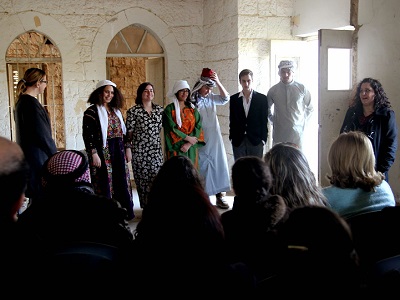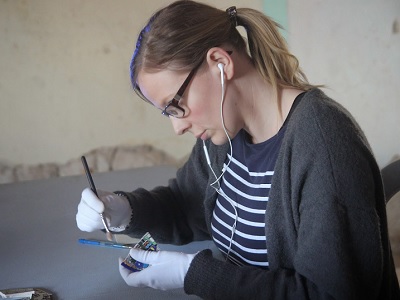
By Sam Bahour
I’m almost embarrassed to admit it. I’ve lived in Palestine for 21 years and passed by the village of ‘Ein Siniya hundreds of times, but can’t recall ever actually visiting it, that is, until today.
‘Ein Siniya is a small Palestinian village in the West Bank’s Ramallah and al-Bireh Governorate, 10 kilometers north of Ramallah, northeast of Jifna, the village renowned for its apricots. It lies in a valley surrounded by olive and fig terraces. Its population has grown from 701 persons in 2007 to 885 today, a whopping 12% increase. It was the home of Faisal Husseini, the legendary Palestinian leader who spent his life defending Palestinian rights in Jerusalem. ‘Ein Siniya is what one would call a sleepy, laid-back village, but today it came alive and I was there to witness this refreshing awakening.
I arrived to ‘Ein Siniya driving behind a minibus from The Danish House in Palestine that was transporting people who were heading to the same venue that I was. Turning off the main road into the village, we turned right and then took the first left. The first thing I noticed is what one usually sees in all Palestinian villages, a group of children. This group was a cheerful one of young girls seemingly excited at all the odd traffic crawling up their street. A few hundred meters up the hill, on the right, was the historic home that we were coming to visit, the home of Mr. Jamil Al Husseini.
Standing in front of this huge, run-down home was actress Faten Khoury. She was oddly standing halfway in the street, not to be missed. She was frozen in a pose, staring at the long, stone staircase that hugged the backside of the building and led to the first floor of this abandoned, eerie home. She held a suitcase in one hand and a white photo album in the other. As we exited our cars and the bus unloaded, many stopped to talk to Faten, but she would not budge. She just stared up the staircase, clearly leading us to where we were to go, without saying a word.
Upstairs we entered through an old, traditional doorway, narrow and with a heavy steel door. We then walked across a sheet of metal flooring, placed on an old outside terrace that led to a large room. Along the way there were rooms to our right, the first had two young girls, in traditional costume, sitting on the floor kneeling bread dough. The next room had a young man, also in traditional dress, manually milling freshly picked olives with a stone. At the end of the terrace walkway we entered a larger room, possibly what was once the family’s living room.
The room was full of people sitting on the ten or so rows of chairs. In the front of the room was a table, with a foreign lady sitting alone. She had her headphones on and reverted back and forth between diligently typing away on her laptop and putting on a pair of white gloves, before picking up an artifact, pieces of a colorful broken ceramic dish, which she used a small brush to meticulously brush the edges of the dish pieces off. We later learned this she was Ms. Emilie Simonsen, a Danish actress visiting Palestine, playing the role of a historic restoration expert.
As we found our seats, more and more people flowed in, young and old. Emilie paid no attention to all the buzz in the room; she just kept doing her thing. Sitting behind me was a row of the most beautiful young girls from the village. The sat diligently waiting, trying to understand who were all these strange people who all of the sudden arrived out of nowhere. I asked them where they were from and what they were all waiting for? Without hesitation, one replied, “We are from here, ‘Ein Siniya, and we await the skit, there is going to be a skit here. Where are you from?” I replied, “Al-Bireh, near Ramallah,” thinking they would only know the larger city near mine. One of the girls, around 9 years old, answered, “I know where Al-Bireh is; it’s where the Al-Bireh Secondary Girls School is located.” I was clearly not needed for these girls to navigate their geography.
Not before long, there was only standing room left. Then entered an older, well-dressed man. He was ushered to sit in the first row. This was the owner of the house, Jamil Al Husseini. It was then announced that the show was about to begin. The room fell silent.
Actress Faten hesitatingly entered the room, still holding her photo album as she placed her luggage to the side. She then spent the next ten minutes thrashing around the room, talking to herself, reminiscing about days long gone. She recalled her father’s descriptions of his home back in Palestine, this home. She walked through the rooms, shocked that, although she never lived in this home, she felt like she knew every nook and cranny—the wooden window frames, the arched windows that separated the rooms, the porch, the now-broken vase sitting on Emilie’s table waiting to be logged in her laptop, the tiled floors, and so on. She spoke of the home as if she could see all its long-gone residents still there. Actually, as Faten reminisced, a group of young actors and actresses from Ashtar Theater were playing out the home’s original family members, as if they had come back to life. As Faten moved from one room to another, she slammed a door, startling Emilie, the foreign actress.

Emilie abruptly stopped bushing the artifact in her hand, threw off her white gloves and removed her headphones to jump up and scold Faten for being in the house. Emilie explained that the house was very old and is being restored and no one was allowed in. Faten replied, in vain, that this was her family’s home and she could envision all the memories as if they were alive. Emilie was unable to see this, being only privy to the material artifacts that she was brushing and logging into her laptop. As photos of past times, when the home was full of life, were displayed on the stone wall of the living room, Faten, frustrated with Emilie’s inability to feel the living past of the home, summed up the stance: “You are only interested in the restoration of the buildings, not the memories.” The audience was moved. I had a serious outbreak of goose bumps.
A few minutes later, the skit ended. It took this talented team of actors and actresses merely twenty minutes to strike a deep chord in each of us. Lost homes, time passed, history maintained through oral storytelling, refugees coming home, today’s material world seeking to merely see the stones and not the families who lived in the homes or what happened to them, or where they went, or how they died. In those short, twenty minutes, a number of deep feelings that every Palestinian has was touched.
Following the skit, the floor was open for discussion. The first to speak, remaining true to our culture, was the owner of the home. He thanked everyone for coming and welcomed us to his home, a heavy-on-the-heart welcome given the condition of the building, but an exceedingly warm welcome taking into consideration that it was now filled, once again, by village boys and girls, adults, and everyone else, most importantly Jamil himself, the homeowner.
When I spoke during the discussion period, I challenged the young ones in the room. I told them I’m going to write this article about the event and want them to send me their reflections so I can include them. Immediately after the event, the entire group of young girls who were sitting in the row behind me came up to me. One of the girls, Bisan, an unquestionable future leader, garnered enough courage to speak to me on their behalf. With her red cheeks and beautiful smile, she said they wanted to ask how they can send me what they write. I gave them my business card and told them my email is listed. One of the girls asked if she can send hers to me on Facebook, or Face, as she called it. Another sign of the times. They were so excited, they made the rest of a normal day great.
I barely got home that evening when I found this message from Bisan:
‘I am Bisan Jabr Ahmed, I was in ‘Ein Siniya theater and I’m ten years old. I felt that this play expressed our Palestinian heritage and took me back to the old days, how our parents used to live, while now everyone is busy with Face. How in the old times my parents and I worked together in our home and how we cooperated and how we disagreed.’
She then asked me to let her know next time I come to ‘Ein Siniya. Bisan and her generation are thirsty to live, while the military occupation that keeps its boot on their necks make it hard for them to even breathe.
Then a few hours later, I received this message:
‘I am Sama’a Khater. I’m nine years old. I loved the skit which was played in ‘Ein Siniya. Although it was short, it expressed the feelings of people in old days, and made me feel very sad.’
The idea to bring Palestinian oral histories to life has been the passion and project of actress Faten Khoury for years. With the support of The Danish House in Palestine and many generous others, she was able to link with the professional Danish actress Emilie who works in Denmark to revive history through theater. This skit was a pilot for a much larger project that Faten is working on, the creation of a Theatrical Museum of Oral History. I support this project wholeheartedly and made it my firm’s current corporate social responsibility project. Please help bring it to life if you can by visiting www.aim.ps/aim-csr.html and making a donation.
Bottom line, ‘Ein Siniya’s population in the 1922 census of Palestine, conducted by the British Mandate authorities, was 114. Today in 2015, ‘Ein Siniya’s population is 885 persons strong. Given every act of the Israeli military occupation for the last five decades has been designed to get Palestinians to leave Palestine, ‘Ein Siniya is a living testament to our resilience and determination to not only remain on the land, but to grow despite all odds. I, for one, commit to redoubling my efforts to ensure that Bisan and her friends will all have a future worth living for.
– Sam Bahour is a Palestinian-American business consultant from Youngstown, Ohio living in Ramallah/Al-Bireh in the West Bank. He is an Advisory Committee member of The Danish House in Palestine and co-author of “Homeland: Oral Histories of Palestine and Palestinians” (1994). He blogs at ePalestine.com. He contributed this article to PalestineChronicle.com.





